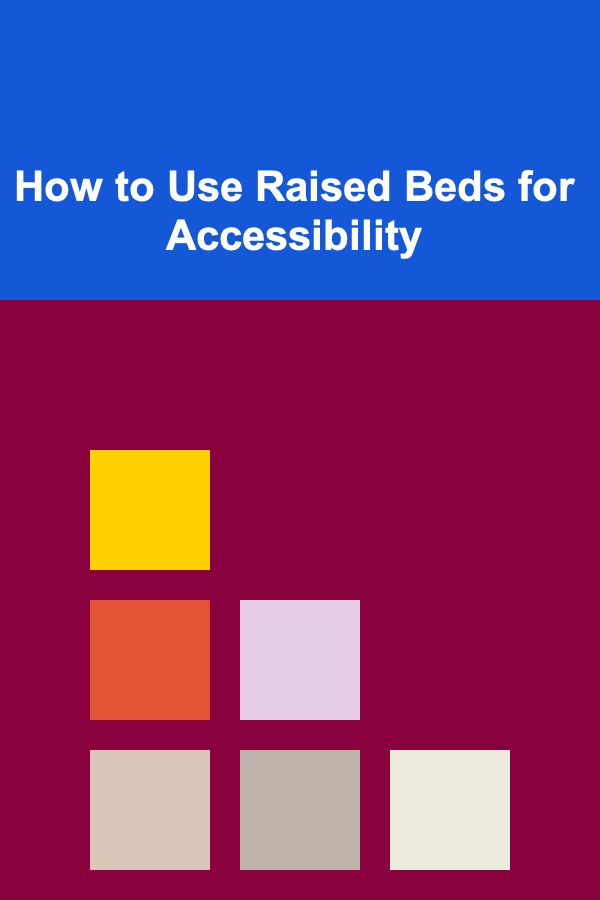
How to Use Raised Beds for Accessibility
ebook include PDF & Audio bundle (Micro Guide)
$12.99$9.99
Limited Time Offer! Order within the next:

Raised beds are an essential feature in many gardens, offering a variety of benefits for both the plants and gardeners who cultivate them. One of the most compelling advantages of raised garden beds is their potential to improve accessibility, making gardening easier and more inclusive for individuals with mobility challenges, disabilities, or simply those who find bending or kneeling difficult. In this article, we will explore the many ways raised beds can be designed and utilized for accessibility, ensuring that gardening remains an enjoyable and viable activity for everyone.
Understanding Raised Beds
Before diving into how raised beds can enhance accessibility, it's important to understand what raised garden beds are and why they are popular among gardeners. A raised garden bed is simply a garden bed that is elevated above the surrounding ground, often bordered by a structure such as wood, stone, or metal. The soil in these beds is typically enriched with compost or other organic matter to improve drainage and provide plants with the best possible growing conditions.
Raised beds come in a variety of sizes, shapes, and configurations, and they can be used for almost any type of plant, from vegetables and herbs to flowers and shrubs. While raised beds can certainly improve soil quality and promote better plant health, they are also incredibly versatile when it comes to enhancing accessibility for a wide range of people.
Why Raised Beds are Important for Accessibility
Gardening has long been recognized as a therapeutic activity with numerous benefits, from reducing stress and improving mental health to promoting physical exercise. However, traditional gardening methods can be difficult or even impossible for individuals with mobility impairments, chronic pain, or limited physical strength. Bending over, kneeling, and reaching to tend plants in ground-level gardens can cause discomfort, fatigue, and strain on joints, particularly for those with conditions such as arthritis or spinal issues.
Raised beds address these challenges by elevating the planting area to a height that is easier to reach, which reduces the need for bending or kneeling. For gardeners in wheelchairs, walkers, or those with limited mobility, raised beds are a game changer, offering greater freedom and autonomy to engage in gardening without pain or strain. Furthermore, raised beds help ensure that everyone, regardless of their physical abilities, can enjoy the benefits of growing their own food or cultivating a beautiful garden.
Key Features for Accessible Raised Beds
There are several important features and design considerations that can help make raised beds truly accessible. By thinking about height, width, materials, and path access, gardeners can create raised beds that cater to a variety of needs and preferences. Let's take a closer look at these considerations:
1. Height
The height of a raised bed plays a crucial role in its accessibility. Ideally, the top of the bed should be at a height that allows the gardener to easily reach the soil and plants without excessive bending or stretching. For individuals who use wheelchairs, walkers, or those with limited mobility, the bed should be tall enough so they can tend to the plants while seated or standing.
The height of accessible raised beds typically falls between 30 and 36 inches (76 to 91 cm). For wheelchair users, the ideal height may be between 30 and 34 inches (76 to 86 cm), which allows the gardener to roll up close to the bed without difficulty. However, the height can be adjusted based on the needs of the individual gardener. Some beds are designed to be higher, even up to waist height, for those who are standing or have trouble bending over. The key is ensuring the bed is within comfortable reach for the user.
2. Width
The width of a raised bed is another important factor to consider for accessibility. If the bed is too wide, it can be difficult to reach the middle of the garden without stretching or walking around the entire bed. A bed that is too narrow, on the other hand, can make it hard for a gardener to maneuver tools or access plants without disturbing the rest of the bed.
For most raised beds, a width of 24 to 36 inches (61 to 91 cm) is considered ideal for accessibility. This width allows a gardener to reach the center of the bed from either side without straining. However, for wheelchair users, beds should be no more than 30 inches (76 cm) wide to allow easy access from the front. If the bed is deeper, paths between beds should be wide enough to allow for comfortable maneuvering.
3. Pathways
Pathways are a key element of accessibility when designing a raised bed garden. If a gardener is using a wheelchair, walker, or cane, it's essential to have wide, level paths between the raised beds that can accommodate their mobility aids. Ideally, the paths should be at least 36 inches (91 cm) wide, though 48 inches (122 cm) or more may be needed for extra maneuverability.
The surface of the paths should also be taken into consideration. Paved, smooth surfaces like concrete, gravel, or compacted soil are preferred, as they allow for easy rolling or walking. Avoiding uneven terrain or large stones can help ensure safety and comfort for those using mobility aids.
4. Materials
When constructing a raised bed for accessibility, it's important to choose materials that are durable, safe, and easy to work with. Common materials used for raised beds include wood, metal, stone, and concrete. Each material has its own advantages and considerations:
- Wood: Pressure-treated wood is a popular choice for building raised beds because it is readily available and easy to work with. However, it is important to ensure that the wood is treated with non-toxic chemicals, as some treatments can leach harmful substances into the soil.
- Metal: Metal raised beds are durable and often provide a sleek, modern look. Galvanized steel is commonly used, as it resists rusting and is relatively lightweight compared to other metals. It can also be molded into various shapes and sizes.
- Stone and Concrete: Stone and concrete are sturdy and long-lasting materials that can be used to create raised beds. While they may require more effort to construct, they provide a natural aesthetic that blends well with outdoor environments.
Whatever material is chosen, it is crucial that it be stable, weather-resistant, and safe for growing plants. Additionally, the edges of the raised bed should be smooth and free from sharp corners that could cause injury, especially for wheelchair users or individuals with limited mobility.
5. Accessibility Features
Some raised beds include additional features designed specifically to enhance accessibility for people with disabilities or limited mobility. These features may include:
- Rotating or Folding Beds: Some raised beds are designed to rotate or fold, allowing the gardener to access all areas of the bed without having to move around it. This feature can be especially helpful for wheelchair users or individuals with limited reach.
- Adjustable Height: Adjustable-height raised beds allow the gardener to modify the height of the bed depending on their needs. These beds can be raised or lowered to suit the comfort level of the gardener, which is ideal for people who have varying mobility levels.
- Ergonomic Tools: When designing a raised bed for accessibility, it is also important to consider the tools used for gardening. Ergonomically designed tools, such as long-handled trowels, weeders, and hoes, can reduce strain on the gardener's hands, wrists, and back.
Benefits of Raised Beds for Accessibility
The benefits of raised beds for accessibility are numerous. Here are just a few ways in which raised beds can improve the gardening experience for people with disabilities or mobility impairments:
1. Reduced Strain and Discomfort
By elevating the garden bed to a height that is easier to reach, raised beds reduce the strain on the back, knees, and joints that is typically associated with gardening. This allows individuals with arthritis, fibromyalgia, or other musculoskeletal conditions to garden without experiencing excessive discomfort or fatigue.
2. Easier Plant Maintenance
For people with mobility impairments, the ability to tend to plants from a seated or standing position can make gardening much more manageable. Raised beds provide easier access to plants, making it simpler to water, prune, harvest, or apply treatments like mulch or fertilizers.
3. Increased Independence
Raised beds can foster a sense of independence for gardeners who might otherwise rely on others to assist them with their gardening tasks. The increased accessibility of raised beds allows individuals with disabilities to engage in gardening activities on their own, which can be both empowering and rewarding.
4. More Efficient Gardening
Because raised beds are easier to reach and maintain, gardeners can spend more time actually cultivating plants rather than struggling with physical limitations. Raised beds also tend to drain better than traditional ground-level beds, which can lead to healthier plants and more productive gardens.
5. Safety and Comfort
For wheelchair users or individuals with balance issues, raised beds reduce the risk of falls or accidents that can occur when bending or kneeling on the ground. By providing stable, elevated planting areas and wide, accessible paths, raised beds promote a safer and more comfortable gardening experience.
Conclusion
Raised beds are an invaluable tool for making gardening more accessible and inclusive. By adjusting the height, width, materials, and layout of the garden, raised beds can be tailored to meet the needs of individuals with a wide range of physical abilities. Not only do raised beds reduce strain and discomfort, but they also provide a sense of independence and empowerment, allowing people with disabilities or mobility challenges to enjoy the therapeutic benefits of gardening.
Whether you're designing a raised bed garden for yourself or for others, it's important to keep accessibility in mind. With thoughtful planning and a few simple modifications, raised beds can open up the world of gardening to everyone, regardless of their physical capabilities. Gardening should be an activity that brings joy, peace, and a connection to nature---no one should have to miss out due to physical limitations.

How to Optimize Storage Solutions in Rental Units
Read More
How to Reorganize Your Bathroom Cabinet After a Move
Read More
How to Save Money on Home Renovations and Remodeling Projects
Read More
How to Use Labels for Quick Identification of Gear
Read More
The Art of Photography: Capturing Moments in Time
Read More
How to Track Vision Insurance Expenses for Multiple Family Members
Read MoreOther Products

How to Optimize Storage Solutions in Rental Units
Read More
How to Reorganize Your Bathroom Cabinet After a Move
Read More
How to Save Money on Home Renovations and Remodeling Projects
Read More
How to Use Labels for Quick Identification of Gear
Read More
The Art of Photography: Capturing Moments in Time
Read More